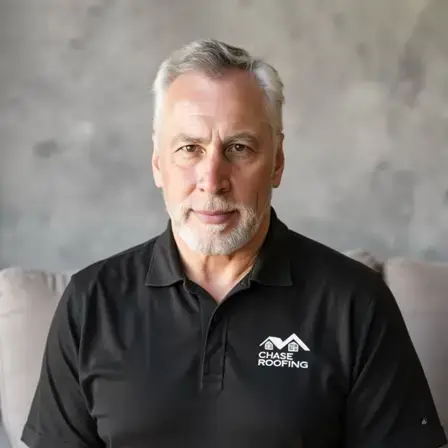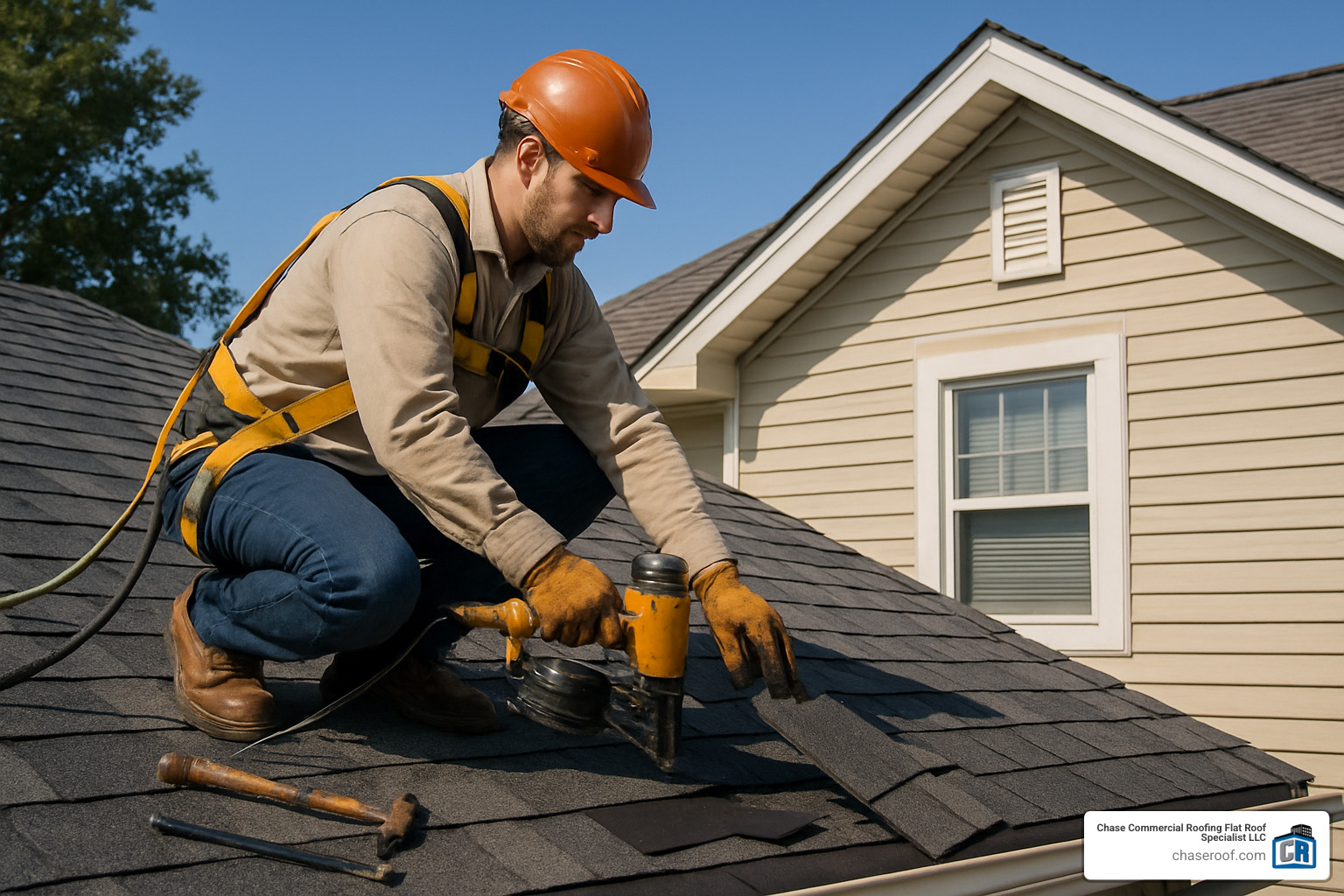Why Commercial Roof Damage Repair Can’t Wait
Commercial roof damage repair is essential for maintaining the structural integrity and functionality of your business premises. If you’re facing roof damage, here’s what you need to know right away:
Quick Guide to Commercial Roof Damage Repair:
1. Inspect immediately after storms or when you notice leaks
2. Document damage with photos for insurance claims
3. Make temporary repairs (tarps, patches) to prevent further damage
4. Contact a certified professional for proper assessment
5. Address repairs promptly to avoid escalating costs and damage
Water intrusion is the leading cause of commercial roof failure, with leaks accounting for over 40% of all commercial roofing problems. When left unaddressed, what starts as a minor issue can quickly escalate into major structural damage, mold growth, and business interruption.
The average commercial roof repair in the U.S. ranges from $4 to $12 per square foot, but neglecting maintenance can increase repair costs by up to 50%. Even more concerning, pooling water due to poor drainage is responsible for up to 70% of premature commercial roof failures.
Regular inspections and maintenance aren’t just recommended—they’re essential. Professional roof inspections conducted twice yearly can extend your roof’s lifespan by 30% or more, protecting your investment and preventing costly emergency repairs.
I’m John Chase, founder of Chase Commercial Roofing, with over 30 years of experience handling commercial roof damage repair for businesses throughout New Jersey. My team and I have seen how timely intervention can save property owners thousands in repair costs and prevent business disruptions.

How to Spot Damage Early: Signs You Need Commercial Roof Damage Repair
Let’s face it—your commercial roof is like the silent guardian of your business. It’s easy to forget it’s even there… until something goes wrong. But waiting for water to literally drip onto your desk is like waiting for your check engine light before changing your oil—it’s already too late.
Early detection is your best defense against costly roof failures. As someone who’s climbed countless commercial rooftops across New Jersey, I can tell you that most catastrophic failures begin as tiny, fixable problems.
Visible cracks or tears in your roofing membrane might seem minor, but they’re open invitations for water to enter your building. Similarly, water stains appearing on ceilings or walls are never “just condensation”—they’re your building’s way of waving a red flag.
Have you noticed unexpected spikes in energy bills? Before blaming your staff for leaving doors open, consider that damaged roof insulation might be the culprit. Your HVAC system works overtime when your building envelope is compromised.
After heavy rain, walk your property and look up—clogged drainage systems or standing water on your roof can add thousands of pounds of weight where it doesn’t belong. And speaking of weight issues, any sagging roof deck areas require immediate professional attention.
Indoor air quality concerns like mold or mildew growth on interior surfaces or unusual odors inside your building often trace back to roof moisture intrusion. By the time you notice these signs, water has already traveled far from its entry point.
Interior Clues of Commercial Roof Damage Repair Needed
Your building’s interior often reveals the first hints of trouble brewing above. Those innocent-looking ceiling water spots or discoloration—typically yellowish or brownish stains—are telling you water has already penetrated your roof system and is quietly seeping through your ceiling.
When you notice peeling paint or bubbling wallpaper, don’t just call the painter. These cosmetic issues often stem from moisture that’s found its way in through roof defects. Similarly, a persistent musty odor that cleaning doesn’t eliminate typically indicates hidden moisture and possible mold growth from a roof leak.
Is your building suddenly harder to heat or cool? When HVAC systems work harder than normal, it could mean your roof insulation has been compromised by moisture. I’ve seen energy bills increase by up to 30% when commercial roofs lose their insulating properties due to water infiltration.
Here’s an important truth: the absence of interior leaks doesn’t guarantee your roof is problem-free. Many commercial roof issues develop silently for months or even years before showing obvious interior signs. By then, the damage—and repair costs—have multiplied.
Exterior Clues Requiring Commercial Roof Damage Repair
Regular roof inspections can save you thousands in repair costs. During your next inspection (or when you call us for a free one), watch for these warning signs:
Blisters or bubbles on the roof surface form when air or moisture gets trapped between layers of roofing material. Like blisters on your skin, they indicate damage beneath the surface. Punctures and penetrations from foot traffic, dropped tools, or storm debris create direct pathways for water entry.
Damaged flashing around roof penetrations, edges, and transitions is among the most common entry points for water. These metal components are designed to create watertight seals at your roof’s most vulnerable junctions.
After rainfall, your flat roof should drain completely within 48 hours. Pooling water that remains longer accelerates membrane deterioration and adds significant weight to your structure. For metal roofing components, watch for rust or corrosion and loose fasteners, both of which can compromise your roof’s watertight integrity.

The ponding water shown above is responsible for up to 70% of premature commercial roof failures in New Jersey. Even small amounts of standing water can significantly shorten your roof’s lifespan by breaking down roofing materials and creating perfect conditions for leaks.
Don’t wait until water is dripping onto your inventory or equipment. At Chase Commercial Roofing, we provide free roof inspections for businesses throughout Woodland Park and surrounding New Jersey communities. Call us today to schedule yours.
For more detailed information on identifying potential leaks before they cause major damage, check out our guide on how to identify roof leaks.
What’s Wrong Up There? Typical Damage Types & Their Causes
Ever wonder what’s actually happening on your commercial roof? As someone who’s climbed thousands of New Jersey rooftops, I can tell you that understanding the enemy is half the battle. Let’s look at what’s really causing those headaches up above.
Wind uplift is more than just a strong breeze – it creates pressure differences that can literally peel your roofing membrane back like opening a can of sardines, especially at corners and edges. During those famous Jersey nor’easters, we’ve seen entire sections of membrane completely detached from buildings.
Hail impact might seem rare, but those frozen projectiles pack a punch. Even smaller hailstones can create tiny punctures that might not leak immediately but become major problems months later. Think of them as time bombs waiting for the next heavy rain.
UV degradation is the silent killer of commercial roofs. That relentless New Jersey summer sun breaks down roofing materials day after day, year after year. Materials become brittle, crack, and eventually fail – like leaving plastic furniture outside for years.
The constant membrane shrinkage from our dramatic temperature swings (sometimes 30-40 degrees in a single day) puts enormous stress on your roofing system. It’s like repeatedly stretching and releasing a rubber band until it finally snaps.
Moss and algae growth might look harmless or even picturesque, but they’re actually roof destroyers. They trap moisture against your roof surface and create the perfect environment for bacteria that eat away at your roofing materials. According to experts, this biological attack can reduce a roof’s lifespan by years. Learn more about this hidden threat in this detailed article on moss growth and bacteria issues.
Structural movement happens more than most building owners realize. Buildings settle, foundations shift slightly, and even minor seismic activity can create stress points in your roofing system – particularly at seams and penetrations.
And let’s not forget foot traffic damage – every HVAC technician, satellite installer, or maintenance worker who walks across your roof leaves a mark. Over time, these seemingly minor impacts add up to significant wear patterns and potential failure points.
Water Leaks & Drainage Failures
Water is incredibly persistent and will find any available path into your building. Here’s how it typically outsmarts your roof:
Ponding water is like having small lakes on your roof. Even a quarter-inch deep puddle that stays for 72 hours can prematurely age that section of your roof by 25%. I’ve seen ponding reduce a 20-year roof to needing replacement in just 12 years.
Clogged downspouts and drains are probably the most preventable yet most common problems we encounter. Those autumn leaves might look beautiful on the trees, but once they land on your roof and wash into your drainage system, they become expensive problems. One fully blocked drain during a heavy rainstorm can put thousands of pounds of extra weight on your roof structure.
Ice dams are a special winter challenge for New Jersey commercial buildings. The freeze-thaw-freeze cycle creates barriers that trap water, which then finds alternative escape routes – usually right into your building.
Capillary action is water’s sneaky superpower – it can actually travel uphill through tiny gaps in materials. I’ve seen water travel over 15 feet from the actual entry point before dropping into a building, making leak detection particularly challenging.
For specialized help with these flat roof drainage issues, visit our Commercial Flat Roof Repair page.
Material-Specific Weaknesses
Each roofing system has its own Achilles’ heel:
EPDM (rubber) roofing offers excellent durability but is particularly vulnerable at the seams. As adhesives age, these seams can separate, creating entry points for water. The material is also susceptible to punctures from dropped tools or sharp debris.
TPO roofing relies on heat-welded seams that can separate over time, especially if the initial installation temperature wasn’t precisely controlled. We’ve seen poorly welded seams fail in as little as 5-7 years.
Metal roofing provides outstanding longevity but faces the constant threat of corrosion, particularly at fastener points where different metals may interact, and at overlaps where water can be trapped.
Built-up roofing (BUR) systems are prone to blistering when moisture gets trapped between layers and expands in the heat – like a balloon ready to pop.
| Roofing Material | Common Weaknesses | Typical Lifespan | Repair Complexity |
|---|---|---|---|
| EPDM (Rubber) | Seam failures, punctures, UV degradation | 20-30 years | Moderate |
| TPO | Seam separations, membrane embrittlement | 15-25 years | Moderate |
| Metal | Corrosion, loose fasteners, panel separation | 30-50 years | High |
| Built-Up (BUR) | Blistering, cracking, surface erosion | 15-30 years | High |
| Modified Bitumen | Granule loss, seam failures, blistering | 15-25 years | Moderate |
Here in Woodland Park and throughout New Jersey, our unique climate challenges put commercial roofs through extreme tests. From scorching summer heat to freezing winter storms, these temperature swings accelerate aging and damage more quickly than in more moderate climates. That’s why local expertise is so crucial when addressing commercial roof damage repair in our region.
Have questions about what might be happening on your commercial roof? Call Chase Commercial Roofing for a free assessment – we’ve seen it all and can help you understand exactly what’s happening up there.
From Panic to Plan: Inspection, Insurance & Professional Repair Process
When roof damage strikes, that initial wave of panic is completely normal. But take a deep breath – we’re going to turn that anxiety into a clear action plan:
- Initial storm assessment – After severe weather passes, safely document visible damage from the ground or accessible points. Never climb onto a damaged roof yourself!
- Comprehensive documentation – Grab your smartphone and capture date-stamped photos and videos from multiple angles. These will be your best friends during the insurance process.
- Temporary protection – If it’s safe to do so, covering damaged areas with tarps can prevent further water intrusion. But remember, safety first.
- Professional inspection – This is where we come in. A certified contractor needs to evaluate the full extent of damage – both obvious and hidden.
- Insurance adjuster meeting – Schedule this on-site visit and have your roofing contractor present. Their expertise ensures nothing gets overlooked.
- Safety planning – Before repairs begin, proper safety protocols must be established to protect workers and your property.
- Repair timeline establishment – Get a clear schedule so you can plan around the disruption.
- Warranty documentation – Always obtain written warranties for peace of mind on all repair work.
Here’s a crucial tip many building owners learn the hard way: making permanent repairs before your insurance claim is approved can sometimes lead to claim denial. Stick to temporary protective measures until you’ve received claim approval. Your patience here can save thousands.
Step-by-Step Professional Inspection
A thorough commercial roof damage repair inspection isn’t just a quick walk-around. Our professional process includes:
Visual examination is just the starting point – identifying obvious damage and potential problem areas. But what makes our inspections truly valuable is looking beyond what’s visible.
Thermal imaging uses infrared technology to detect moisture trapped beneath the roof surface – often revealing problems that haven’t even created visible leaks yet. This technology can spot wet insulation long before ceiling stains appear.
Core cuts involve taking small samples from strategic roof locations to assess all layers of the roofing system. This helps us understand the full extent of damage and determine if underlying insulation has been compromised.
Moisture mapping creates a detailed diagram of wet areas, helping us develop a targeted repair plan rather than unnecessarily replacing dry, functional sections.
At Chase Commercial Roofing, we don’t just look for what’s broken today – we identify potential weak points that could become tomorrow’s emergency. Our certified inspectors use advanced technology to provide a complete picture of your roof’s condition.
For more details about our thorough inspection and repair process, visit our Commercial Roof Repair page.
Filing & Managing Claims
The insurance claim process can feel like navigating a maze, but we’ve guided countless New Jersey business owners through it:
Create detailed photo logs that document all damage from multiple angles with good lighting. Before-and-after photos are particularly powerful evidence.
Complete all claim forms thoroughly with specific details about when and how the damage occurred. Vague information gives adjusters reasons to delay or deny claims.
Research code upgrade requirements for Woodland Park and New Jersey. Many insurance policies include “ordinance or law” coverage for bringing repairs up to current building codes – something easily overlooked but potentially worth thousands.
Prepare for possible claim denials by understanding common rejection reasons. Insurance adjusters often initially attribute damage to wear and tear rather than covered events like storms. Having documentation and a knowledgeable advocate can make all the difference.
Insurance adjusters work primarily for insurance companies, not you. Having a knowledgeable roofing contractor present during adjuster inspections helps ensure all legitimate damage is properly documented and classified correctly. We’ve helped many clients receive fair settlements by simply explaining technical aspects of damage that adjusters sometimes misclassify.
For more guidance on navigating roof damage insurance steps, the Roofers Guild provides helpful information.
Execution of Repairs
Once your claim is approved, our repair process prioritizes both quality and efficiency:
Material staging begins with organizing all necessary materials on-site in a way that won’t cause further damage to the roof. We carefully plan weight distribution and access points.
Crew safety protocols are implemented before work begins, including fall protection systems and other OSHA-required safety measures. We never compromise on worker safety.
Quality control checks happen at critical points throughout the repair process, not just at completion. This ensures issues are caught and corrected immediately.
Final walkthrough involves a comprehensive inspection after repairs are complete, often inviting building owners to join us so we can explain what was done and answer any questions.

Professional repairs like this TPO seam welding require specialized equipment and trained technicians. What might look simple is actually a precise process requiring exact temperature control and pressure. Proper seam welding creates a molecular bond that’s stronger than the membrane itself – critical for ensuring a watertight roof system that will perform for years to come.
The quality of your commercial roof damage repair depends largely on the expertise of your contractor. At Chase Commercial Roofing, our teams are manufacturer-certified and regularly updated on the latest techniques and materials, ensuring your repairs are done right the first time.
Budgeting & Hiring Right: Costs, Claims & Contractor Selection
Let’s talk dollars and sense when it comes to fixing your commercial roof. As a business owner, you need clear numbers to make smart decisions.
Most commercial roof damage repair costs fall between $4-$12 per square foot in our New Jersey market. This range accounts for different roof types, damage severity, and the specific materials needed. About 60-70% of what you’ll pay goes toward skilled labor—those experienced hands that ensure your repair is done right the first time.
Several factors can impact your final bill. Buildings with difficult access points, extreme heights, or businesses that can’t shut down during repairs often require special accommodations that affect pricing. And here’s something many property owners don’t realize: putting off small repairs can balloon your costs by up to 50% when water damage spreads to insulation, structural elements, and interior finishes.

For a more detailed breakdown of what goes into roofing costs, Forbes offers an excellent breakdown of roof repair costs that aligns with what we see in the New Jersey market.
Repair or Replace? Decision Matrix
I’ve helped hundreds of New Jersey business owners wrestle with this crucial question. Here’s my practical advice:
Age matters tremendously. If your roof has already lived through 75% or more of its expected lifespan, investing in repairs might be throwing good money after bad. Think of it like maintaining an old car—at some point, the math simply favors starting fresh.
Damage patterns tell a story. Isolated problems in an otherwise sound roof? Repair makes sense. But when you’re chasing leaks across multiple areas, that’s your roof’s way of saying it’s ready for retirement.
Energy costs provide clues too. Many of my Woodland Park clients have finded that their aging roofs were silently draining their bank accounts through poor insulation and heat loss. A new, energy-efficient roof system can actually pay back a portion of its cost through reduced utility bills—especially important with New Jersey’s seasonal temperature swings.
For a comprehensive assessment of whether replacement makes more sense for your situation, visit our Commercial Roof Replacement page for guidance specific to New Jersey commercial buildings.
Choosing the Best Team
Finding the right contractor for your commercial roof damage repair isn’t just about getting the lowest bid. It’s about finding a partner who’ll protect your business investment.
Start with the basics: proper licensing and insurance that meets New Jersey state requirements. This isn’t just paperwork—it’s your protection against liability and substandard work.
Emergencies don’t wait for business hours. Make sure your contractor offers genuine 24-hour emergency response. When water is pouring into your building at 2 AM during a Woodland Park thunderstorm, you need someone who answers the phone and takes action.
Experience with your specific roof type matters enormously. EPDM, TPO, modified bitumen, and metal systems each require specialized knowledge and equipment. Ask to see examples of similar projects they’ve completed in the New Jersey area.
Demand clarity in writing. A professional proposal should clearly outline scope, materials, timeline, and costs without vague language or hidden charges. If they can’t explain something clearly on paper, that’s a red flag.
The right roofing partner will take time to walk your property, listen to your concerns, and educate you about your options without pressure tactics. They’ll understand Woodland Park’s specific building codes and the unique weather challenges we face in New Jersey.
For situations that can’t wait, our 24 Hour Commercial Roof Repair team stands ready to protect your business when every minute counts.
Prevention Is Profit: Maintenance Strategies to Avoid Repeat Damage
Think of your commercial roof as a silent guardian—protecting everything beneath it day after day. Like any hardworking hero, it needs regular care to stay in fighting shape.
Biannual professional inspections are your roof’s best friend. Schedule these in spring and fall—right before and after our harshest New Jersey weather seasons—to catch small issues before they become budget-busting emergencies. At Chase Commercial Roofing, we’ve seen how these regular check-ups can extend a roof’s life by 30% or more. That’s not just smart maintenance—it’s smart business.
Debris removal might seem like a simple task, but it’s surprisingly powerful preventive medicine. Those innocent-looking leaves, branches, and litter can trap moisture against your roofing materials and block drainage paths. A clean roof is a happy roof!
Drainage system maintenance deserves special attention. In my 30+ years working on New Jersey commercial roofs, I’ve seen more damage from clogged gutters and drains than almost any other cause. When water can’t find its intended exit path, it creates its own—usually straight into your building.
Reflective coatings offer double benefits for Woodland Park businesses: they extend your roof’s lifespan by reducing UV damage while simultaneously cutting your cooling costs. Think of them as sunscreen for your building. Learn more about our protective roof coatings that can improve energy efficiency while adding years to your roof’s service life.
Walkway pads are worth their weight in gold for roofs with regular foot traffic. These simple additions protect vulnerable roofing materials from punctures and wear patterns, especially around HVAC units and other equipment that requires regular maintenance.
Training your maintenance staff properly can prevent unintentional damage. Make sure anyone accessing your roof understands safe walking paths, weight limitations, and how to properly work around sensitive roofing components.
For comprehensive guidance on keeping your commercial roof in peak condition, visit our Commercial Roof Maintenance Tips page.

Regular maintenance tasks like drain clearing shown here aren’t just busywork—they’re essential protection. I’ve seen a single clogged drain cause thousands in damage during one heavy downpour. An ounce of prevention truly is worth a pound of cure.
Frequently Asked Questions about Maintenance & Inspections
1. How often should commercial roofs be inspected?
Your commercial roof needs professional eyes on it at least twice yearly—typically spring and fall. But don’t stop there. After any significant weather event (hailstorms, high winds, heavy snow), a quick inspection can catch damage before it spreads. Think of these extra check-ups as insurance for your insurance—they help ensure small problems don’t grow into denied claims.
2. What emergency steps should I take after storm damage?
When Mother Nature leaves her mark on your roof, timing matters. First, document everything with photos and videos—your insurance company will need this evidence. If it’s safe to do so, cover damaged areas with tarps to prevent further water intrusion. Then call us for emergency assessment at Chase Commercial Roofing—we provide 24/7 response for exactly these situations. Notify your insurance company promptly, and keep detailed records of all temporary repairs and related expenses.
Remember: don’t attempt permanent repairs until a professional has assessed the damage and your insurance claim has been processed. Premature repairs can complicate your claim.
3. Does preventive maintenance really cut long-term costs?
The numbers don’t lie. Every dollar invested in preventive maintenance saves $3-$4 in future repair costs. It’s like changing your car’s oil regularly instead of waiting for the engine to fail. Well-maintained roofs last about 30% longer than neglected ones, which means you’re effectively postponing that major replacement expense by years. For a typical commercial building in Woodland Park, that translates to tens of thousands in savings over time.
Long-Term Protection Plans
Smart building owners think beyond the next repair. Consider these comprehensive protection strategies:
Service contracts provide peace of mind through scheduled professional maintenance. We’ll remember the maintenance dates even when your busy schedule doesn’t.
Leak-free warranties back up quality repair work with guarantees. At Chase Commercial Roofing, we stand behind our workmanship with solid warranties because we’re confident in our solutions.
Coating renewal programs ensure your protective roof coatings remain effective. In New Jersey’s challenging climate, where we experience everything from summer heat waves to winter ice storms, these coatings can be the difference between a roof that ages prematurely and one that provides years of additional service.
Roof coatings deserve special mention for New Jersey commercial buildings. Our region’s weather extremes—scorching summers and freezing winters—accelerate aging in traditional roofing materials. A quality coating creates a renewable surface that can be refreshed without the disruption and expense of a full replacement.
At Chase Commercial Roofing, we’ve helped countless Woodland Park businesses develop maintenance strategies that protect both their buildings and their bottom lines. Call us today for a free estimate and let us help you create a customized maintenance plan that keeps your roof performing at its best year after year.
Conclusion
When it comes to commercial roof damage repair, we’re not just fixing today’s problems—we’re safeguarding your business investment for years to come. At Chase Commercial Roofing Flat Roof Specialist LLC, we’ve spent more than 30 years helping businesses across New Jersey keep their roofs watertight, energy-efficient, and structurally sound.
Our team knows Woodland Park’s unique roofing challenges inside and out. From sudden summer thunderstorms to heavy winter snow loads, New Jersey weather puts commercial roofs through the wringer. We’ve developed specialized approaches that address these regional challenges while minimizing disruptions to your daily operations.
Here’s what we’ve learned from three decades of helping local businesses:
Early detection saves thousands. Those twice-yearly inspections we recommend? They catch small issues before they become budget-busting emergencies. Many of our longest-standing clients haven’t needed major repairs in years because we catch problems when they’re still minor fixes.
The most expensive repair is the one you postpone. What starts as a small membrane tear can quickly turn into damaged insulation, soaked drywall, and even structural wood rot. Addressing issues promptly is always the most affordable approach.
Professional expertise matters. Commercial roofing systems are complex, with multiple components that must work together seamlessly. Our certified technicians understand these interactions and deliver repairs that last.
Maintenance isn’t an expense—it’s an investment. Our clients who follow regular maintenance plans typically extend their roof’s lifespan by 30% or more, significantly delaying the much larger cost of full replacement.
Don’t wait until you’re placing buckets around your office during the next rainstorm. Our team stands ready 24/7 for emergency situations, and we’re happy to provide free, no-obligation estimates for any commercial roofing project.
Contact Chase Commercial Roofing today to schedule your complimentary roof inspection and consultation. We proudly serve businesses throughout Passaic, Newark, Paterson, Jersey City, Hackensack, Woodland Park, East Rutherford, and all of New Jersey.
Need immediate help with a roofing emergency? Visit our emergency roof repair page for more information on our rapid response services.







